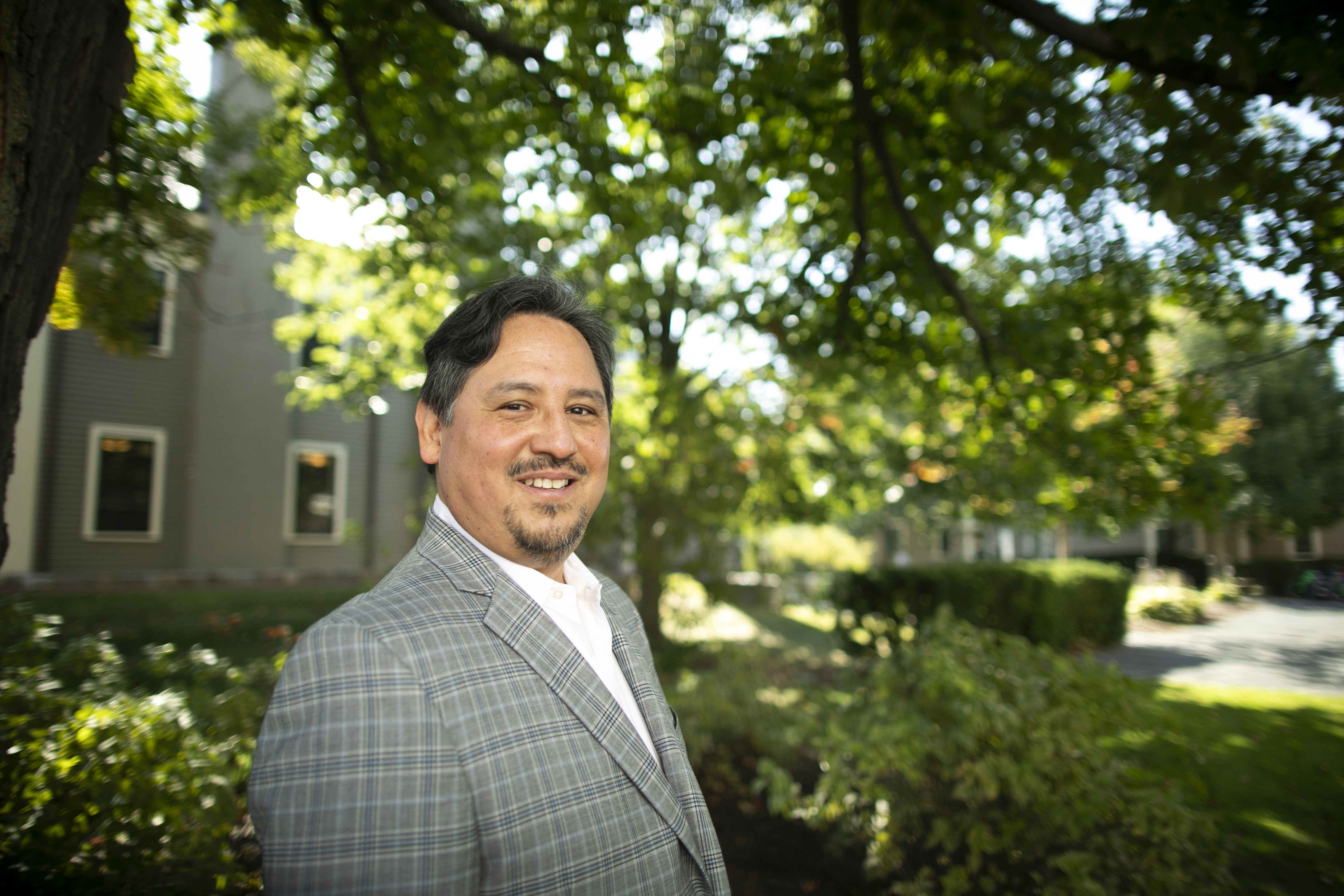Joseph Gone is a professor of both Anthropology and Global Health and Social Medicine at Harvard University. He is a clinical and community psychologist by training, and he conducts participatory research projects with community partners in Native American communities. His projects aim to rethink traditional mental health practices and incorporate Indigenous-healing practices. His work includes both the critical analysis of psychological theories and concepts, such as indigenous historical trauma, as well as original research on new mental health programs such as the Blackfeet Culture Camp for the treatment of addiction.
As an undergraduate, he became interested in psychology because the field approaches the question of human experience from so many diverse vantage points — taking up questions from the workings of the brain to what it means to be human. His love for ideas and his desire to contribute to the American Indian communities (as a member of Aaniiih-Gros Ventre tribal nation) led him to get a doctorate in clinical psychology. However, his experience is not simply that of a clinical psychologist or psychotherapist who addresses mental health at the individual level — because sometimes, he explains, the remedies that help people “look less like healing and more like justice.”
The transcript below has been edited for length and clarity. Listen to the audio of the interview here.
Ayurdhi Dhar: You’ve talked about historical losses that the indigenous people have incurred in the past and present. Could you speak to the nature of these losses?
Joseph Gone: ‘Losses’ is a great term for it because indigenous people in the United States have lost an awful lot, but ‘losses’ is also a little too passive. It hasn’t just been lost. It has been extinguished, eradicated. We have been deprived of a lot because of the entire colonial encounter. European powers who colonized what now is the United States came to dispossess Indian people of our land, lives, well-being, and of our ability to determine our future for ourselves and our children. We were kept captive on reservations under severely impoverished conditions that often led to starvation or disease outbreak.
The United States expected American Indian people to vanish, so we would no longer be a problem population. But that thankfully never happened. Despite all odds, we have persisted. Our survival is marked by an acute historical awareness and a recognition of these losses. These losses are something that we carry, similar to the way other populations who have been victimized, subjugated, and oppressed throughout history, can carry these things. One way that we make meaning of this is by determining our future for ourselves, and by finding continuity with the past in ways that America did not want us to do.
The consequences of our colonization are the enduring mental health inequities or disparities, particularly addiction, trauma, and suicide. These inequities didn’t arise because our brains suddenly went bad or because we had bad genes. This came about in the process of conquest, colonization, and dispossession. Ordinarily, the mental health professions make sense of these issues by assuming that there is something wrong with the person. This person needs a desperate remedy, perhaps therapy, or some way of intervening in their individual bodies and lives to restore them to well-being.
But a lot of this stuff is shared, collective, and passed down from early actions of impoverishment and subjugation. The historical context is critical and differs from the person-blaming explanations of the mental health profession. It recognizes that these problems arose as a result of these colonial encounters and not just because the individual is deficient and to be blamed. If you feel that way, it is very hard to recover the idea of a healthy, happy, or valuable self.
But if you re-frame those difficulties as a legacy we share because of our victimization in the past, it empowers you and changes you in profound ways. So historical trauma is the concept that captures this dynamic, which recognizes our problems today but anchors their origin in our histories of oppression so we can get out of the paralyzing self-blame narratives. We have to re-socialize a series of issues that have been medicalized for a long time, which in turn has led to individuation where only the individual is the site of therapeutic engagement. With historical trauma, it is about entire communities that have been deliberately impoverished and are in need of desperate remedies. This may look less like healing and more like justice.
Dhar: The mental health fields, psychology, and psychiatry have a dark and racist past. Were there any ways in which psychology contributed to the culture of discrimination against the American Indian people?
Gone: Within anthropologically informed psychology of indigenous peoples, there were ideas about primitivity, which helped the American campaign to assimilate Indian people into civilized life, which was devastating. It’s not that Indian people wouldn’t want to learn English, but maybe they wouldn’t have signed on for Christianization or an education system that prepared them for the lowest rungs of the socioeconomic hierarchy.
Dhar: You developed the new concept of indigenous historical trauma, which has gained widespread recognition. What did you find lacking about the old theory which did not translate to the experience of indigenous people?
Gone: Indigenous historical trauma is a synthesis of two older concepts. One is historical oppression, and the second is psychological trauma, which burst into the mental health professions in 1980 with PTSD. So, we have a new way of talking about the suffering that both recognizes a broader social and historical context and also languages it in a way that’s new and can command attention.
Because indigenous people are such a small proportion of the national population, getting our needs addressed involves obtaining a hearing first. Being creative with our language in ways to designate and identify things is crucial to get media and policymakers to listen.
Dhar: A few months ago, I interviewed Diana Kopua, who is a Maori psychiatrist and has developed a radically different way of conceptualizing Maori suffering and experience because the usual mental health language was unhelpful to her. Do you think it is possible to create a universal knowledge, like psychology, which can do justice to the experience and suffering of cultures across the world?
Gone: The desire for a universal language is to facilitate common communication among clinicians, professionals, and policymakers so they can recognize the same types of experiences of distress. So, psychiatry has been endeavoring to create diagnostic and statistical manuals that have reliable categories. The danger is that it could reify and export experiences of illness and suffering that are particular to the context in which the DSM is designed.
The people involved in creating the DSMs would be the first to tell you that these are stand-in categories based on the research we have, and the research we have is wholly inadequate. Therefore, the categories are very provisional. Additionally, the export doesn’t just happen from people interested in communicating and studying. It comes from capitalism and the desire and motivation of drug companies to promote and sell their inventions.
There are other forces at work that have a big stake in these categories being exported. Now it is probable that there are some kinds of disorders, brain disorders, where one may generalize cross-culturally, but there are other disorders that are mostly cultural in terms of their patterning, and their experience and expression. For example, dissociative identity disorder is more about scripts, performance, narratives, and ideas of the self that ebb and flow. We had an epidemic of multiple personality disorder in the United States in the 1990s. It really is a story about culture more than it is about the brain.
In American Indian communities, there is a well-developed discourse that runs parallel to the discourse of mental health. Historical trauma is the linchpin of that because it is an alternative, or I might say ‘alter-native’ way of talking about indigenous suffering that, in some cases, rejects DSM diagnostic categories. It has different views about what it means to be a healthy person, which is not necessarily neoliberal individualism, where free agents navigate free markets in pursuit of happiness, success, and productivity. Instead, it deals with one’s location within a kinship network and position relative to the unfolding of a community’s existence.
The interventions that people need may not be the latest scientifically-driven, empirically-supported treatments, but rather a return to tradition, and the revitalization of indigenous healing. The evaluation of whether these interventions work is less about scientific efficacy and more about indigenous ways of knowing, sometimes called indigenous epistemologies. It’s a vast scholarly project to figure out what are the advantages and disadvantages of each of these claims. I’m not saying that these claims should be widely accepted necessarily at this point. I’m describing what we see and hear in Indian country and what scholars should know.
Dhar: In an old paper, you talk about something you’ve called anti-colonial prescription of healing. Could you say more about these traditional healing methods and their efficacy?
Gone: Indigenous healing is a term that is often opposed to something like treatment. One must recognize that indigenous communities, prior to the arrival of biomedicine, had doctoring practices. Today, in indigenous communities, what we talk about as an alternative to mental health discourse is transformative healing, which is more about transforming the self into what is more conducive to well-being. This is more of a process. In Indian Country, it’s about spirituality, and ceremonial participation, and many people advocate for it: indigenous ceremony, ceremonial participation, sweat lodge ceremony, Sundance ceremonies, etc.
Anytime one participates in a ceremony, which involves prayer and sacrifice, it benefits them in ways that are conducive to health. In this way, prayer is health-inducing and might be conducive to recovery from problems, including mental health problems. One can be skeptical about this, as scientists often are, but it is very difficult to design the kinds of studies to test this. What we do have are thousands and thousands of Indian people who will attest to the fact that they’ve contended with these serious issues and been helped by culture and tradition, even those whose problems were quite severe.
Dhar: In my work with people in the Himalayas, people would similarly use ceremonies called jaagars to help with anything from mental distress, hallucinations, to back pain — human suffering. They swear by how effective their ways are. But there is very little good research on this.
Gone: Every healing tradition has adherents who will claim that they have experienced a miracle cure, and of course, we want to be skeptical about random claims. So it’s not just taking people’s word for it, but we must follow up to try and trace what makes the most sense.
None of the conditions mental health professionals deal with would occur without clinically significant impairment or distress. Also, when people are suffering, their feelings ebb and flow. So someone telling you they feel better doesn’t mean they are going to feel better in 12 or 24 hours or next week or month. Assessing whether people feel better is important, but we would be remiss if that’s all we assessed. We must have some basic skepticism and recognize the limitations of all of our sources of knowledge.
Dhar: As a discipline, a culture, and a nation, where are we in acknowledging long-term intergenerational impacts of colonialism, and where do you see this work heading in the future?
Gone: The United States is not all that aware of its colonial history and does not recognize it. People know that native people got a raw deal, but they do not understand the full extent of it. They do not understand that people today still suffer because of the arrangements that were set up at the birth of the nation, and they don’t have a clue about what Indian people want or need.
We live in a paradoxical society where Indians are simultaneously everywhere and nowhere. There are sports mascots on TV, and the streets and states are named after Indians. But if you survey most Americans, they don’t know any Indian people and can only come up with a historical figure like ‘Crazy Horse’ or ‘Sitting Bull’ or ‘Chief Joseph.’ Any time Indian people try to speak to an audience, the public only wants to hear what already fits with their preconceptions. It becomes very difficult to speak in a genuinely self-determined way.
The kinds of resources that would improve our lives dramatically are really not very large. A couple of fighter bombers converted to Indian affairs would probably do it. In this respect, it’s not a very hard problem to address.
One of the best studies on Indian mental health was the Great Smoky Mountains Study in North Carolina. It followed Indian and White youth over the course of their development and assessed them for mental health problems. The tribal community in question developed a casino as the study started and started to have an income and distribute it to the Indian families. The growth of mental health problems slowed for the native Indians but not for the white youth who didn’t have any income supplement. So that tells you that income and adequate resources in your household matter a lot. The single best thing that would alter mental health in indigenous communities is meaningful livelihoods, good jobs that make you proud, organize your life, and keep you busy.
We can train all the counselors in the world and send psychiatric medications into the reservation, but the mental health sector is not going to solve the problems of Indian country. It is sort of like a Band-Aid on a gushing artery at this point. For example, harnessing traditional ceremony and sacred practice as mental health intervention could be useful for some mental health conditions in Indian country. The epidemic problems in the Indian country are addiction, trauma, violence, and suicide, and these can be helped because those behaviors and conditions are heavily mediated by the meanings we make.
These meanings are patterned through the colonial experience where our own self-image is tied up in expectations and understandings that we are less than worthy. A return to tradition and ceremony is not just religious, but it’s also about identity and belongingness and plugging into something that’s continuous with the past.
Dhar: There is a movement around decolonizing psychology that sees interiorizing problems of living as mental health issues as a disservice to the suffering of people who face discrimination and exploitation. You have spoken about how the DSM can similarly decontextualize the problems of indigenous people. Could you talk more about such culturally unique meaning-making?
Gone: The modern DSMs, in their rebellion against psychoanalysis, tried to be a-theoretical, to stay away from origin stories, etiologies, and tried to only be descriptive with the level of signs and symptoms. But of course, it is impossible to be completely a-theoretical. You have to have a set of assumptions about human emotion and experience, even to posit what kinds of illnesses would be relevant.
If you are coming from a community where you have been socialized to be more relationally attuned, then your identity is tied up in a collective identity of kin. That interdependence is readily apparent in indigenous societies, and it extends to the foundations of human experience like human emotion.
Emotion is itself culturally constituted, and we are socialized into it. Emotion without the meaningfulness of a script, an expectation, and a label in a language is nothing more really than impulse. In many indigenous communities, social emotions like pity, or what might be called compassion, stand out. So, pity is a feeling state cast within a relational network.
Similarly, people recognize insane jealousy, which can lead to domestic or family violence. Again, jealousy is a feeling state evoked in a relational context. In other words, there’s a whole parallel way to think about emotional experience and expression that is relational. What would it look like to develop a set of categories of pathology that were grounded in social emotion? These alternative possibilities are impossible under a universalizing, a-theoretical framework.
The question is to what degree is it doing violence to impose those kinds of categories that may not fit. If you’re not careful, patients will reify their diagnosis in their own lives. That creates a loop where professionals socialize their patients into experience and expressions of disorders, which are researched over time. But the research is based on the people who have been socialized to experience and express distress in that way. So, the knowledge created depends on the knowledge that was disseminated to begin with, which alters a whole mode of life over time.
For example, once you tell people about PTSD and you show them the symptoms and explain what they’re experiencing, then some symptoms probably fade away, whereas others might come online, which validates or legitimates our concept of PTSD. That feeds back into the research we do on those patients whose experience has been molded by us. You wed it to the capitalist endeavor of marketing, especially for pharmaceuticals, and then you have something that might be dangerous.
Dhar: I come from two generations of refugees and a military family, and the experience of suffering could never fit into the discourse of PTSD. So, I’ve always wondered about the importance of meaning-making experiences post-trauma.
Gone: Yes, people are impacted by horrors all the time, but it doesn’t mean they become sick, even if it shapes their identities in really profound ways. I see what historical trauma is trying to do, but it also has limitations. It originated to re-socialize the medical to recognize the historical context, but at the same time, it is primarily a health discourse, and if you do not step out of the clinical frame of reference, then you are still involved in medicalizing the social.
But to step entirely out of health is to abandon the claim on health resources, which is the primary way that societies make help available to those who are suffering. So you can understand why people want to maintain their claim on health resources. But then it involves the casting of the legacy of oppression into the broader medical theater where suffering is interiorized and individuated. It distracts us away from the broader systemic and structural kinds of issues.
Dhar: In one of your papers, you say that Western cultures often construct other cultures in ways where only those in the West appear objective. The stance is “we have the knowledge, they have beliefs.” But you say Western knowledge is equally embedded in the practices of power and ethnocentrism, and that the concepts and categories of psychology are not transcendent or culture-free. Could you say more?
Gone: It might be helpful to maintain a distinction between knowledge and belief but to assert that mental health professions have the knowledge and that indigenous peoples who proclaim other things merely have beliefs is a deformity of recognizing how knowledge circulation happens. Mental health professionals are chock full of beliefs. People promoting evidence-based practice have been saying that too much of what mental health professionals do is belief-based. But with certification and licensure, their expertise is codified and identified as authorized knowledge. Local communities of people don’t only have beliefs. They also know things that are true and can be important collaborators if we are to understand their experience.
So it’s really a question of what is the role of skepticism. How can we arbitrate skeptical inquiry in a way that will make sense to different audiences? Because some audiences are toxically skeptical, they’re nihilists. Others are so gullible that it borders on foolishness. Native mental health professionals and researchers sit in an interesting place between these different audiences. For native mental health professionals, to talk to these different audiences is a challenge and a demand, and a real opportunity.
Dhar: Thank you so much for your time, Dr. Gone.
**
Photo Credit: Stephanie Mitchell/Harvard Staff Photographer
****
MIA Reports are supported, in part, by a grant from the Open Society Foundations





I appreciate the professor’s perspective on DID as a cultural epidemic as opposed to a legitimate illness or affliction, and especially how the expectations of our families, friends, and providers shape our individual experience of a particular diagnosis. If we could only get the well-meaning helpers to understand that their beliefs about these diagnoses actually help shape the experiences of their loved ones, so that they would stop labeling them with such nonsense and instead help them heal as whole individuals, that would be transformative for so many traumatized people who have been led to believe these constructs are real.
As for the DSM, it’s harmful to EVERYONE, not just Americans or westerners. The issue isn’t that it’s not culturally sensitive to indigenous peoples, it’s a steaming pile of horse shit that’s harmful to all it’s applied to.
Lastly, speaking of “American” culture as if there is such a thing – like we’re not a young country with many overlapping and competing cultures, is rather ignorant.
Report comment
My comment reads a little harsh. To be clear, overall, I thought it was a great interview! 😀
Report comment
Although I agree with most of your comment I would like to ad that DID is a rare label to get.
Report comment
Removed for moderation.
Report comment
“looks less like healing and more like justice”. I can agree with that statement. “some audiences are toxically skeptical, they’re nihilists”. I do like the latest catchword. Amazing how our language keeps using old words to describe aspects to people’s behaviours, beliefs, or how we invent new ones. I can now call a woman down the street as “toxic”, to anyone that I choose to. I have the ability to label someone, from the DSM. In the old days, she was just “not a nice person”. Now she is toxic. And I have the ability to make others suspicious of her based on that word. I really dislike that word because it was borrowed from the DSM. Every guy and his dog is now a shrink. And as far as middle ground, where exactly is that?
Report comment